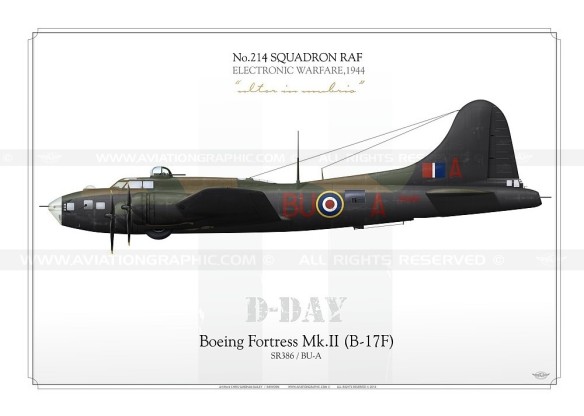Boeing B-17 Fortress II ‘BU-A’ SR386 of 214 Squadron.
No account of Operation Overlord would be complete without mention of the deception operations conducted against the Germans. Since there was no disguising the imminence of the invasion, it was essential to its success that the enemy be misled about the actual location of the assault.
Imaginative, elaborate and realistic intelligence deceptions, for example utilising double agents, `dummy’ forces and `spoof’ radio traffic, played no small part in this campaign over the weeks and months preceding D-Day.
As the date for the invasion drew closer, the air campaign continued to sow confusion by attacking more targets north of the Seine and in the Pas-de-Calais area than in Normandy. However, on the eve of D-Day the lion’s share of the credit for successfully blinding, confusing and misleading the Germans, must go to the air operations conducted by a relatively small number of specialist aircraft and crews. So successful were these operations that the German High Command retained Wehrmacht divisions north of the Seine and in the Pas-de Calais, even after the invasion in Normandy had occurred, in the belief that this was where the main blow would fall. These enemy forces could, potentially, have made a major difference if they had been deployed to Normandy early enough. They might have turned the tide entirely and they would, at the very least, have inflicted greater casualties on the Allied troops during the initial break out from the invasion beaches.
From the night of June 4-5, 1944, the specialist RCM aircraft of 100 (BS) Group, including USAAF B-17 Fortresses of 803 Squadron, which were attached to 100 Group, set up a radar jamming `Mandrel screen’ to cover the invasion fleet from the `eyes’ of those German radars which had survived the earlier attacks by Allied fighter bombers.
On the eve of D-Day, June 5-6, all the jamming squadrons of 100 Group were in the air performing their specialist duties. First up, around dusk, were 199 and 214 Squadrons. 199 Squadron Stirlings took up station at 15,000ft at intervals along the south coast of England, spread from Dorset to Dover.
Flying at precisely determined intervals, heights and bearings the aircraft jammed German radar across the entire central and eastern English Channel, masking the invasion fleet.
Meanwhile, B-17 Fortresses of 214 Squadron and a small force of 101 Squadron Lancasters were heading east to fly over Calais and along the Somme Valley, penetrating 80 miles into France then turning around to fly back and forth across the Channel.
On each inward run `Window’ bundles were tossed out as fast as possible. Just 10 aircraft created on German early warning radar a `ghost’ bomber stream of hundreds of non-existent raiders heading for precisely those targets that would have been chosen if the invasion were taking place near Calais, distracting the German’s attention from Normandy. The Fortresses also jammed the German fighter control radio frequencies with their special on-board equipment.
An electronic wall, blocking all German communications and radar, was established for several hours over northern France, masking the presence of the huge and vulnerable force of Allied transport aircraft and the gliders they towed, on their way to deliver airborne forces as the precursor to the invasion.
D-Day ‘Spoof’ operations
While the specialist `jammers’ of 100 Group did their work, three other special air operations added to the trickery that the Germans had to contend with on the eve of the invasion. Operations Taxable and Glimmer, flown by 617 Squadron Lancasters and 218 Squadron Stirlings, created `spoof’ invasion fleets, while Operation Titanic conducted by Special Duties Halifaxes and Stirlings generated decoy airborne landings.
The effectiveness of Taxable and Glimmer
The real D-Day assault into Normandy was supposed to have been completely masked by the radar jamming of the specialist 100 Group RCM aircraft.
That jamming, it transpired, was insufficient to overcome the powerful German radars that had survived earlier attacks, whose operators did in fact detect and report the real invasion fleet heading towards Normandy. By that point, however, the Germans were in a state of disarray and confusion, which had been added to by the `spoof’ invasion fleets simulated by Taxable and Glimmer.
While some German officers wanted to respond to the real invasion, others refused to accept it for what it was and would not believe the reports they were receiving. The fact is that potent German forces were kept in the Pas-de-Calais area, even after the invasion in Normandy had occurred, in the belief that this was where the main blow would still fall, proof indeed of the success of the numerous deception operations, including Taxable and Glimmer.
The commander in chief of RAF Bomber Command, Air Chief Marshal Sir Arthur Harris, sent a message to the air crews involved which said: “It is already established that the operations on which you engaged on the night of June 5-6 were very successful and it may well be when the full facts are known it will be found that you achieved results of even greater importance than can be known at present.”
